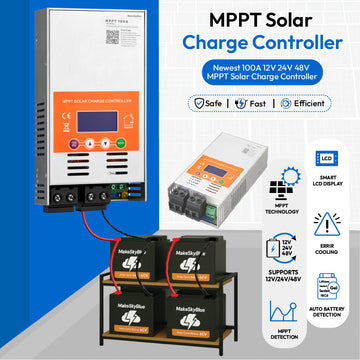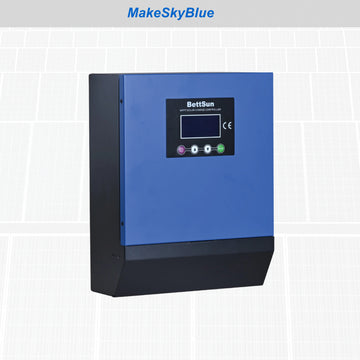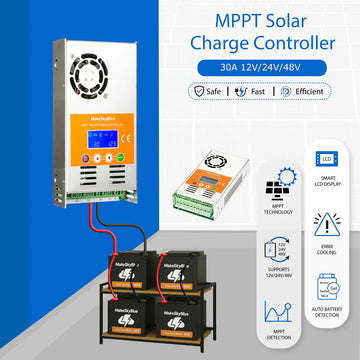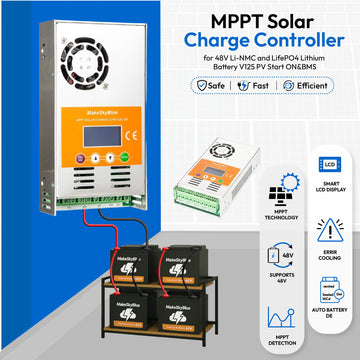The best way to enjoy power on the road is by using the solar panels in your RV. However, solar panels will not ensure the protection of your batteries. This is one area where an rv solar charge controller plays his role. It manages the movement of power, eliminates overcharge, and makes your battery system last longer. Without a good controller, your battery could get damaged due to irregular charge.
In this guide, we will explain everything about charge controllers. You will learn about the types, features, sizes, and best options for RVs. We will also compare PWM and MPPT solar charge controllers in detail.
What is a Solar Charge Controller?
A solar charge controller is a regulator that regulates the current that passes through the solar panels to the battery. It ensures that the battery is filled with the ideal voltage. When the battery is full, it decreases or halts the charge to prevent overcharging.
Think of it as a gatekeeper. Solar panel can generate more voltage, however the controller ensures that the battery just gets what it can smoothly handle. It also prevents reverse current at night when no solar power is available.
Why Do You Need a Charge Controller in an RV?
When you live in or travel with an RV, power management is essential. Solar systems are popular because they provide clean energy. But without a controller, the battery system can face damage.
-
It prevents overcharge of lithium or flooded batteries.
-
It regulates voltage and current coming from the solar panels.
-
It improves the lifespan of the battery bank.
-
It allows safe connection of larger solar systems.
Whether you have a small trailer or a big RV with a 300Ah battery bank, a charge controller for RV is a must-have.
Types of Charge Controllers
There are two main types of solar charge controllers used in RVs:
PWM Charge Controllers
PWM means Pulse Width Modulation. These are simple and cost-effective. They work by gradually reducing the amount of power sent to the battery as it gets full.
MPPT Solar Charge Controllers
MPPT means Maximum Power Point Tracking. These are advanced controllers that adjust the voltage to extract maximum power from solar panels.
Comparison Between PWM and MPPT Solar Charge Controllers
|
Feature |
PWM Solar Charge Controller |
MPPT Solar Charge Controller |
|
Efficiency |
70–80% |
95–99% |
|
Best For |
Small RVs, trailers, 12V |
Large RVs, 24V/48V systems |
|
Price |
Low |
Higher |
|
Battery Compatibility |
Basic batteries, AGM, car |
Lithium, AGM, flooded |
|
Solar Panel Voltage |
Must match battery |
Can be higher than battery |
|
Example Use |
10A or 20A small setup |
30A, 40A, or 50A systems |
This table explains why the MPPT controllers are more effective in a larger system, and PWM is effective in a smaller setup.
How to Choose the Right RV Solar Charge Controller
The choice of controllers will be determined by the size of your battery, solar panels and power requirements. Here are key points to check:
Amp Rating: Match with the current from solar panels. For example, a 30 amp controller works for 400W solar panels at 12V.
Battery Type: Ensure it supports your battery type (AGM, lithium, flooded).
System Size: Larger systems need MPPT; smaller ones can use PWM.
Voltage Support: Make sure it supports 12V or 24V systems, depending on your RV setup.
Common RV Solar Charge Controllers and Their Features
|
Model |
Type |
Amp Rating |
Battery Support |
Extra Features |
|
Victron Energy SmartSolar MPPT |
MPPT |
30A / 40A |
Lithium, AGM, Flooded |
Bluetooth, App Control |
|
Renogy Wanderer 30A 12V PWM |
PWM |
30A |
AGM, Gel, Flooded |
Affordable, Simple Setup |
|
Morningstar ProStar MPPT 40A |
MPPT |
40A |
Lithium, AGM, Flooded |
Advanced Regulator, Display |
|
Renogy Rover 40A MPPT |
MPPT |
40A |
AGM, Lithium, Flooded |
LCD Display, Larger Systems |
|
Waterproof PWM 20A |
PWM |
20A |
Car, AGM, Trailer use |
Waterproof, Budget Friendly |
Benefits of Using MPPT Controllers in RVs
MPPT charge controllers are becoming more popular among RV owners. They provide:
-
Higher efficiency in extracting solar power
-
Ability to handle larger solar panel arrays
-
More reliable charging for lithium batteries
-
Better performance in cloudy conditions
If you use heavy appliances in your RV, an MPPT solar charge controller is the best choice.
Final Thoughts
A solar system connected to an RV is centered on an rv solar charge controller. It secures your battery system, controls the flow of current through the solar panels and it enhances efficiency. The decision regarding PWM or MPPT will depend on your battery bank and your size of RV.
For small trailers or car battery setups, PWM is budget-friendly. In bigger RVs that have lithium batteries and 300Ah banks, MPPT is an ideal choice. Spending on high-quality controllers from Victron Energy, Renogy, and Morningstar normally provides years of safe and reliable solar power.
FAQs
What does an RV solar charge controller do?
It regulates the voltage and current coming from the solar panels to the RV battery. This prevents overcharge, reverse current, and extends battery life.
Which is better for RVs, PWM or MPPT charge controllers?
PWM is cheaper and works well for small RV solar systems. MPPT is more efficient, especially for larger systems with higher wattage and lithium batteries.
How do I size a solar charge controller for my RV?
Check the total current coming from the solar panels. Divide solar watts by battery voltage, then add 25% safety margin.
Can I use an MPPT solar charge controller with lithium batteries?
Yes, most modern MPPT controllers are compatible with lithium, AGM, and flooded batteries. They also have settings to optimize charging for each type.
Do I need a waterproof solar charge controller for my RV?
In case your controller is positioned in a wet area or out of doors, a waterproof PWM or MPPT controller should be considered to avoid any damage and be safe.




